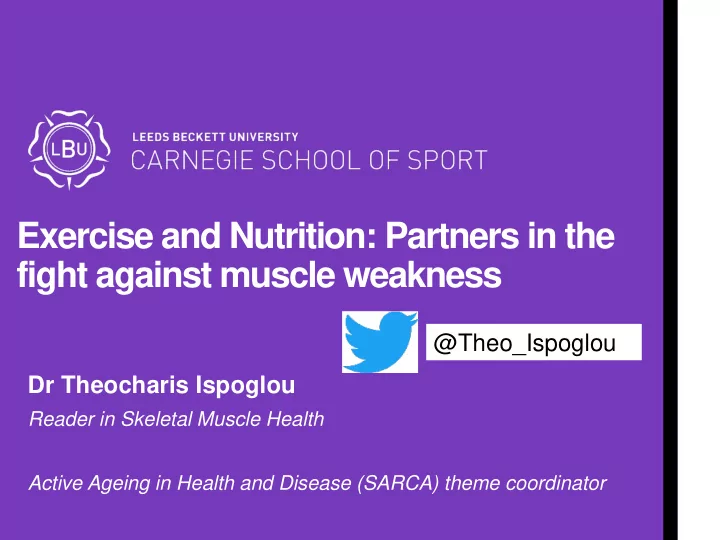

Exercise and Nutrition: Partners in the fight against muscle weakness @Theo_Ispoglou Dr Theocharis Ispoglou Reader in Skeletal Muscle Health Active Ageing in Health and Disease (SARCA) theme coordinator
Topics Background Sarcopenia Potential causes and consequences Exercise and Nutrition Modifiable Risk Factors Sharing some of our research findings
Sepulveda et al. (2015) Background
Sarcopenia Key issues driving our research Frailty and decreased physical activity Inadequate energy and protein intake 4
René SARCOPENIA Koopman, and Luc J. C. 6 van Loon (2009)
Functional decline and link with non-communicable diseases Kuh et al (2014) 7
“The total public expenditure on malnutrition in health and social care was estimated to be £19.6 billion, with older adults accounting for 52% of the total. (2011-12) 8 Elia (2015)
Sarcopenia Dementia ~13 million people over ~5-13% for those 60-70 ~850,000 people with the age of 65 in UK years of age and up to dementia in the UK, with 50% in over 80s numbers set to rise to over 1 million by 2025. ~ 40,000 people under 65 with dementia in the UK Sources: Office for National Statistics, Alzheimer’s Society ~70% of patients with dementia had sarcopenia http://www.jarcp.com/629-prevalence-of-sarcopenia-in-elderly-with- dementia-institutionalized-a-multicenter-study.html
Key points Good Evidence for the role of Resistance exercise (RE) and Protein Supplementation as a means to promote muscle mass, bone health, and functional capacity. Supporting evidence for improvement of ADL and reduction in the risk of falls in people with dementia who partake in exercise interventions Nutritional deficiencies in older people Exercise and Nutrition Modifiable Risk Factors
Effect of resistance training on functional capacity in chronic diseases. Pasanen et al. (2017)
Effect of combined endurance and RE on functional capacity in chronic diseases. Pasanen et al. (2017)
Effectiveness of exercise programs to reduce falls in older people with dementia living in the community: a systematic review and meta-analysis (Burton et al. 2014)
Resistance Exercise Plus Protein Supplementati on Cermak et al. (2012): Outcome-Fat Free Mass
Resistance Exercise Plus Protein Supplementation Cermak et al. (2012): Outcome-1RM Strength
Protein Intake in Older Individuals Daily recommendations of 0.8 g . kg - This is what 30g 1. Bm . d -1 inadequate is too low to avoid protein looks like…… sarcopenia Need for higher protein per meal-at least 30g or 0.4 g . kg -1. BM . d -1 per meal Challenge : age-related anorexia and satiating effects of protein 16
Protein is the most satiating macronutrient Preload 60 50 Hunger (0-100) 40 Fat 30 Carbohydrate 20 Protein 10 0 0 30 90 Time (min) Poppitt et al., 1998. Physiol Behav 64: 279-85.
Older individuals have a higher leucine threshold and they would benefit from larger amounts of leucine either PB within a meal or as a protein/EAAs supplement (Katsanos et al., 2006, Bauer et al., 2015, Ispoglou et PS al., 2016, Phillips et al., 2016, Komar et al., 2015, Yang et al., 2012, Pennings et al., 2011, Verreijen et al., 2015). Total protein intake , protein intake per meal , or leucine intake 18
Tieland et al (2015)
Per Meal Protein Intake 40 35 30 Protein Intake (g) 25 20 15 10 5 0 Breakfast Lunch Dinner Meal Older people do eat enough protein per meal- especially at breakfast and lunch. Green line indicates recommendations (unpublished PhD data, Matt Butterworth) 20
Our Research One of our key objectives to address protein and energy deficiencies 21
Pilot study (Ispoglou et al. 2016) 22
Follow-up study (Ispoglou et al. 2017) When considering the satiating effects of EAAs-based nutritional supplements enriched with leucine, no studies have examined the impact on appetite and concurrent mealtime intake 24 nor the practical aspects of palatability
Development of prototypes (Bar and gel) Nutritional information per 100 g: - BAR : energy 1511 kJ, fat 8.2 g, carbohydrate 47.5 g, protein 25.4 g of which 15 g was EAAs, fibre 2.8 g, salt 0.2 g. - GEL : energy 967 kJ, fat 0.0 g, carbohydrate 47.5 g, protein 15 g which was entirely due to the EAAs content, fibre 0.5 25 g, salt 0.2 g.
Our nutritional prototypes (GEL and BAR) are effective means to facilitate an increase in protein and energy intake when taken one hour before an ad lib breakfast meal. (Ispoglou et al. 2017)
Our nutritional prototypes (GEL and BAR) are effective means to facilitate an increase in protein and energy intake when taken alongside an ad lib breakfast meal. Ispoglou et al (2017)
Follow-up project 29
Our GEL is effective means to facilitate an increase in protein and energy intake when taken one hour before an ad lib breakfast meal. PhD Project (Manuscript under review, PhD student Matt Butterworth) 30
Composite appetite ratings for CON ( ▼ ), WP ( ● ) and GEL ( ○ ).Values are mean (SEM), n=10 . 31
Whey protein enhances satiety and as a result people eat less 32
PhD Project (Manuscript under preparation, PhD student Kelsie Johnson) Hunger perceptions and energy intake was lower in older adults when compared to younger adults. Ageing increased concentrations of; CCK, leptin, insulin and PYY These hormones all promote feelings of fullness whilst attenuating feelings of hunger which could provide explanations towards the anorexia of ageing (Abstract, NutSoc2018)
Our current and future research is primarily focused on strengthening evidence base of exercise and nutrition/nutritional supplementation: Health and wellbeing : Prevention of sarcopenia in healthy older individuals contributing to retention of lean tissue mass, prevention of osteoporosis and enhanced functional capacity. Clinical settings : Treatment of sarcopenia in frail older individuals in chronic disease conditions such as respiratory, rheumatoid arthritis, diabetes, CHD and CF, liver and gastro-intestinal disease, where increased protein requirements may be a result of enhanced requirements or malabsorption. Present and Future 34
35
Thank you Any questions? Staff Webpage: http://www.leedsbeckett.ac.uk/staff/dr- theocharis-ispoglou/ LinkedIn: https://www.linkedin.com/in/theochari s-ispoglou-b7b71a2a/ Twitter: @Theo_Ispoglou
Recommend
More recommend